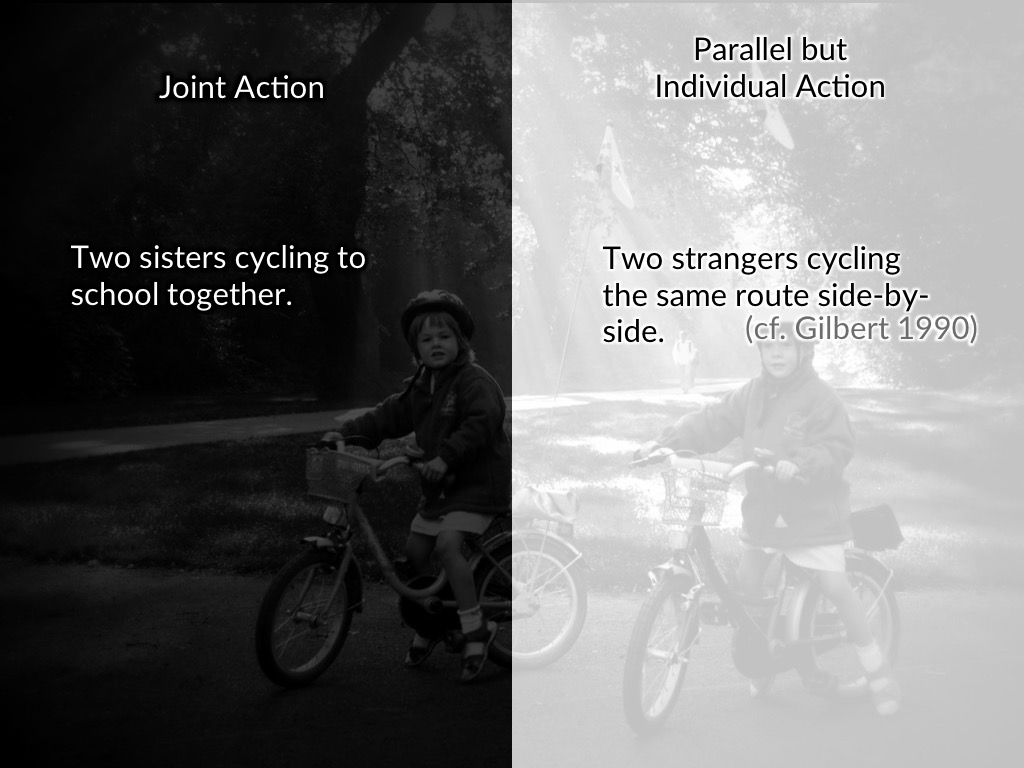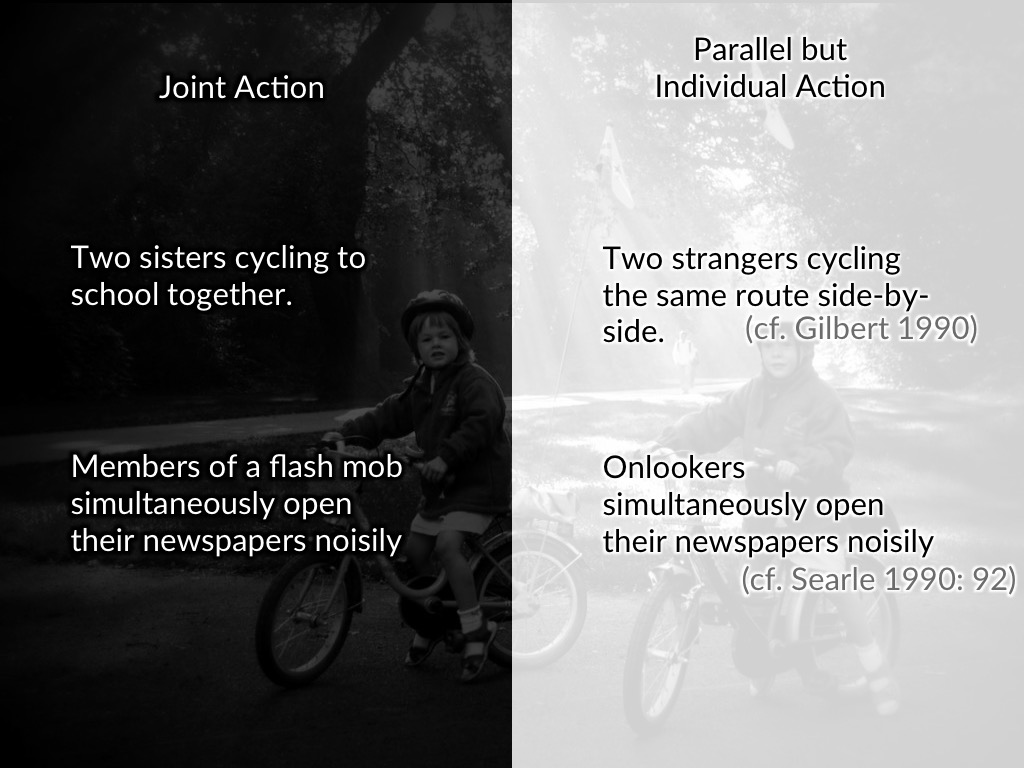Click here and press the right key for the next slide (or swipe left)
also ...
Press the left key to go backwards (or swipe right)
Press n to toggle whether notes are shown (or add '?notes' to the url before the #)
Press m or double tap to slide thumbnails (menu)
Press ? at any time to show the keyboard shortcuts

Question
What distinguishes genuine joint actions from parallel but merely individual actions?


The Simple View
Two or more agents perform an intentional joint action
exactly when there is an act-type, φ, such that
each agent intends that
they, these agents, φ together
and their intentions are appropriately related to their actions.

The Simple View
Two or more agents perform an intentional joint action
exactly when there is an act-type, φ, such that
each agent intends that
they, these agents, φ together
and their intentions are appropriately related to their actions.




‘each agent does not just intend that the group perform the […] joint action.
‘Rather, each agent intends as well that the group perform this joint action in accordance with subplans (of the intentions in favor of the joint action) that mesh’
(Bratman 1992: 332)
We have a shared intention that we J if
‘1. (a) I intend that we J and (b) you intend that we J
‘2. I intend that we J in accordance with and because of la, lb, and meshing subplans of la and lb; you intend [likewise] …
‘3. 1 and 2 are common knowledge between us’
(Bratman 1993: View 4)

Luke’s objection
- Ayesha intends that they J1 in accordance with and because of Ahmed’s intention that they J2
- This is tantamount to Ayesha intending that Ahmed’s intention be fulfilled.
- Manifestly, they only way for Ahmed’s intention to be fulfilled is if Ayesha and Ahmed J2.
Can Ayesha rationally fail to intend that they, Ayesha and Ahmed, J2?
If not, they meet Bratman’s sufficient conditions for having a shared intention that they J2.
Joint Action
Parallel but Merely Individual Action
Two people making the cross hit the red square in the ordinary way.
Beatrice & Baldric’s making the cross hit the red square
Two sisters cycling together.
Two strangers cycling the same route side-by-side.
Members of a flash mob simultaneously open their newspapers noisily.
Onlookers simultaneously open their newspapers noisily.
Question
What distinguishes genuine joint actions from parallel but merely individual actions?

Gilbert on Joint Commitment
Intentions are associated with commitments.
Shared intentions are associated with commitments to each other (contralateral commitments).
Gilbert: joint commitment
‘a commitment
by two or more people
of the same two or more people.’
Contrast personal commitment (by me, of me)
Contrast contralateral commitment (by me, of me, to you)
joint commitment is ‘the collective analogue of a personal commitment’
Gilbert (2013, p. 85)
The tiny drops fell from the bottle.
- distributive
The tiny drops soaked Zach’s trousers.
- collective
Their thoughtless actions soaked Zach’s trousers.
- ambiguous (really!)
Ayesha and Beatrice are committed to walking
- also ambiguous (?)
- when collective, it is a joint commitment
Gilbert: joint commitment
‘a commitment
by two or more people
of the same two or more people.’
Contrast personal commitment (by me, of me)
Contrast contralateral commitment (by me, of me, to you)
joint commitment is ‘the collective analogue of a personal commitment’
Gilbert (2013, p. 85)
A joint commitment is a commitment we have collectively,
so
a joint commitment is simply a commitment.
But Gilbert says
joint commitments have
a special kind of content tooand that joint commitments entail contralateral commitments,
which indicates that
a joint commitment is not simply a commitment.
Gilbert: All joint commitments are commitments to emulate, as far as possible, a single body which does something (2013, p. 64).
‘What is a “single body” [...]? whereas a single human being constitutes a single body [...], a plurality of human individuals does not in and of itself constitute such a body. [...] however, such a plurality can emulate such a body—one with a plurality not only of limbs, eyes, and ears, but also of noses and mouths’
Gilbert (2013, p. 116)
‘a “body” here is understood to be a non-collective body.’
‘some of the things we may share an intention to do are designed for two or more participants ... Sally and Tim are jointly committed to intend as a body to produce, by virtue of the actions of each, a single instance of a tennis game with the two of them as participants in that game’ (Gilbert 2013, p. 117)
Gilbert on joint commitment
[1] The subject:
‘a commitment
by two or more people
of the same two or more people.’
[2] The content:
All joint commitments are commitments to emulate, as far as possible, a single body which does something (2013, p. 64).
A joint commitment is a commitment we have collectively,
so
a joint commitment is simply a commitment.
But Gilbert says
joint commitments have a special kind of content too
and that joint commitments entail contralateral commitments,
which indicates that
a joint commitment is not simply a commitment.
commitment:
personal
contralateral
collective (?)
shared (?)
sense of (?)

Distributive / Collective / Shared
distributive
vs
collective commitment (or intention)
vs
shared (or joint) intention (or commitment)
Ayesha and Beatrice played the horse in our pantomime.

conclusion
- Gilbert offers an account of joint commitment.
- There are some questions about how to interpret her account.
- Gilbert differs from Bratman in two ways: (i) commitment; (ii) collective (vs shared).